Solar eclipse of January 1, 1889
| Solar eclipse of January 1, 1889 | |
|---|---|
| Type of eclipse | |
| Nature | Total |
| Gamma | 0.8603 |
| Magnitude | 1.0262 |
| Maximum eclipse | |
| Duration | 137 s (2 min 17 s) |
| Coordinates | 36°42′N 137°36′W / 36.7°N 137.6°W |
| Max. width of band | 175 km (109 mi) |
| Times (UTC) | |
| Greatest eclipse | 21:16:50 |
| References | |
| Saros | 120 (54 of 71) |
| Catalog # (SE5000) | 9255 |
A total solar eclipse occurred on January 1, 1889. A solar eclipse occurs when the Moon passes between Earth and the Sun, thereby totally or partly obscuring the image of the Sun for a viewer on Earth. A total solar eclipse occurs when the Moon's apparent diameter is larger than the Sun's, blocking all direct sunlight, turning day into darkness. Totality occurs in a narrow path across Earth's surface, with the partial solar eclipse visible over a surrounding region thousands of kilometres wide. It was visible across western United States, and central Canada. Partiality was visible across the northern Pacific ocean including Hawaii, and all of the United States.
Observations and predictions

A drawing of map of path across the western United States and central Canada
Related eclipses
Saros 120
This eclipse is a part of Saros series 120, repeating every 18 years, 11 days, and containing 71 events. The series started with a partial solar eclipse on May 27, 933 AD. It contains annular eclipses from August 11, 1059 through April 26, 1492; hybrid eclipses from May 8, 1510 through June 8, 1564; and total eclipses from June 20, 1582 through March 30, 2033. The series ends at member 71 as a partial eclipse on July 7, 2195. Its eclipses are tabulated in three columns; every third eclipse in the same column is one exeligmos apart, so they all cast shadows over approximately the same parts of the Earth.
The longest duration of annularity was produced by member 11 at 6 minutes, 24 seconds on September 11, 1113, and the longest duration of totality was produced by member 60 at 2 minutes, 50 seconds on March 9, 1997. All eclipses in this series occur at the Moon’s descending node of orbit.[1]
| Series members 50–71 occur between 1801 and 2195: | ||
|---|---|---|
| 50 | 51 | 52 |
 November 19, 1816 |
 November 30, 1834 |
 December 11, 1852 |
| 53 | 54 | 55 |
 December 22, 1870 |
 January 1, 1889 |
 January 14, 1907 |
| 56 | 57 | 58 |
 January 24, 1925 |
 February 4, 1943 |
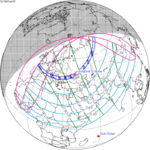 February 15, 1961 |
| 59 | 60 | 61 |
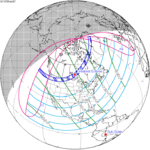 February 26, 1979 |
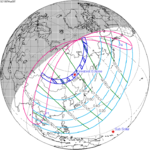 March 9, 1997 |
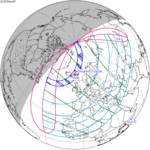 March 20, 2015 |
| 62 | 63 | 64 |
 March 30, 2033 |
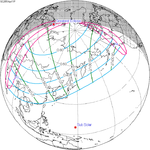 April 11, 2051 |
 April 21, 2069 |
| 65 | 66 | 67 |
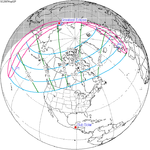 May 2, 2087 |
 May 14, 2105 |
 May 25, 2123 |
| 68 | 69 | 70 |
 June 4, 2141 |
 June 16, 2159 |
 June 26, 2177 |
| 71 | ||
 July 7, 2195 | ||
Notes
- ^ "NASA - Catalog of Solar Eclipses of Saros 120". eclipse.gsfc.nasa.gov.
References
- NASA chart graphics
- Photo of Solar Corona January 1, 1889
- Total Eclipses of the Sun, By Mabel Loomis Todd, 1894, new and revised edition by David P. Todd, 1900. [1]
- Eclipse of June 1, 1889. Contact print from the original glass negative. Lick Observatory Plate Archive, Mt. Hamilton. [January 1, 1889?!]
- On the solar eclipse of January 1, 1889 Holden, E. S., Journal: The Observatory, Vol. 12, p. 130-134 (1889)
- The Total Solar Eclipse of January 1 Nature 39, 487-488 (21 March 1889)
- C.E. Watkins photo / eclipse / lick observatory 1889?, The J. Paul Getty Museum, Object Number: 88.XM.92.83






